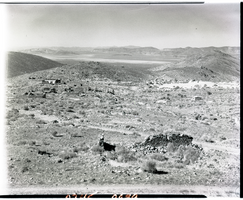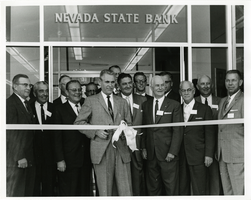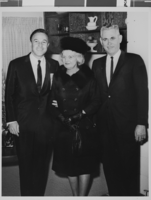Search the Special Collections and Archives Portal
Search Results

Film transparency of a ghost town, Delamar, Nevada, 1956
Date
Archival Collection
Description
Image

Film transparency of a ghost town, Delamar, Nevada, 1956
Date
Archival Collection
Description
Image

Photograph of Mayor Oran K. Gragson cutting the ribbon at the opening of Nevada State Bank, Las Vegas, Nevada, circa 1960s
Date
Archival Collection
Description
Image

Photograph of Mayor Oran K. Gragson, his wife Bonnie with Gene Kelly, circa 1960s
Date
Archival Collection
Description
Image
Cherry, Naomi, 1924-2014
Taken from her obituary on Las Vegas Review Journals' site: "NAOMI CHERRY Naomi Cherry, of Las Vegas, passed away Feb. 21, 2014, after a long and joyful life. She was 89 years of age and a beloved mother, grandmother and great-grandmother. She leaves behind a devoted family and wonderful friends gathered over a lifetime. Born Dec. 1, 1924, in St. Louis, to parents, Abe and Jenny (nee Pollock) Barg, she was the eldest of five siblings, loved to dance and graduated from Soldan High School.
Person
Mildred J. Heyer Photograph Collection
Identifier
Abstract
The Mildred J. Heyer Photograph Collection consists of four black-and-white photographic prints and negatives from approximately 1905 to 1940. The photographs depict early Las Vegas, Nevada street scenes, an irrigation pump, and Liberty’s Last Stand, a prominent saloon in Nevada during Prohibition.
Archival Collection
George Mortimer Photograph Album of Searchlight, Nevada
Identifier
Abstract
The George Mortimer Photograph Album of Searchlight, Nevada dates between approximately 1900 and 1910, and contains black-and-white photographic prints illustrating various scenes and individuals in Searchlight, Nevada. Some images are captioned with initials or brief names.
Archival Collection
Mulidore, Jimmy, 1937-
Jimmy Mulidore grew up very poor in a predominantly Italian town in Youngstown, Ohio. His father and grandfather both worked for Youngstown Sheet and Tool steel mill. However, Mulidore’s father was against his son working at the mill, instead buying him a saxophone between the ages of 8-10 years old. Determined to chart a different course for his son, Mulidore’s father urged him to learn how to play the saxophone and added, if he did, he would not end up in the steel mill. Adhering to his father’s request, he started lessons with Albert Calderon.
Person

